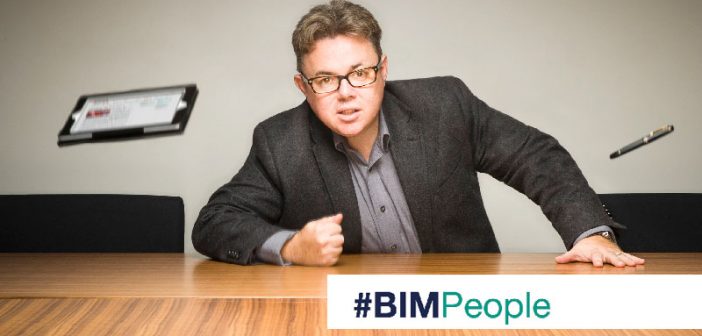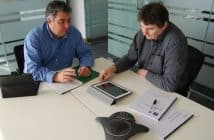David Philp is the AECOM Global Consultancy Director of Building Information Modelling (BIM) and Information Management, Chair of the Scottish BIM Delivery Group and a member of UK BIM Task Group Core Team. David will be a Judge at this year’s Irish BIM Innovation Awards.
Here David talks to BIMIreland.ie about his career and his work in BIM.
Please give us an overview of your career?
Following university (BSc Building Engineering & Management and MSc Property & Construction Management) I started off my career at Balfour Beatty as a Graduate Engineer working my way through the ranks to Director of Technical Services and BIM Programme Director. The formative days were banging in setting out pins (badly). What I would have given for today’s total stations and data enabled heavy plant. I then joined Mace as Head of BIM before joining my current employer AECOM. It has been an exciting journey to date and technology has been a key theme, life-long learning has been pivotal and to this day I am still studying and still have a student card for the cheap haircuts (doing a PhD – BIM related research of course!). The last ten years of my career have been the most exciting with industry riding a new wave of innovation and exciting technological and indeed cultural changes. The lens moving over a whole-life approach to our built environment is also exciting! I am lucky that my boss who is based across in Phoenix encourages us to challenge current conventions and gives us time and room to make change happen. Working with the UK BIM Task Group and SFT BIM working Group is also an amazing experience and a real privilege which I never take for granted. I want to do my best to serve industry and make it better for the next generation who will get all this digital stuff from the off – we just need to ensure that we create an industry that will appeal and they will want to come into – innovative and diverse.
Please tell us why and when you became interested in BIM?
My interest in BIM was born out of Virtual Design and Construct (VDC) and how digitisation coupled with integrated working methodology could optimize project outcomes. I studied VDC at Stanford which was a really good experience. I liked how VDC and BIM could facilitate a better before built workflow where you could prototype in a digital environment, test your hypothesis and refine it several times virtually before executing on site. There was also a really good collaborative BIM community forming that had lots of energy and different ideas about transforming industry in a digital future, I wanted to be part of that journey.
Can you tell us about your work as Global BIM/IM Consultancy Director at AECOM?
It is a pretty cool role, I get to meet some amazing clients with big visions that are interested in how data-centric approaches can optimize the performance and reliability of their asset portfolio and digitise their asset management strategy.
For many clients, this current data deluge in terms of volume (big data), velocity, variety and veracity can be confusing and unapproachable. As part our Lifecycle Data Science solution along with our global team I help clients remove that struggle of coordinating multi-vendor data through an integrated approach to information management. With the use of deep analytic modelling we query past and current operational performance to predict and shape the future.
Whilst BIM is a big part of what we do, increasing we are seeing more demand as to how clients can sweat their data harder to give insight and better outcomes. 2016 is the year of analytics and dashboards! A lot of our work is progressively data science related and focused on interpreting data to turn it into a competitive advantage.
What are the main projects which AECOM has utilised BIM on? Can you tell us about them?
One of the most interesting BIM related projects we have at the moment is the Sydney Opera House in New South Wales where an AECOM-led consortium is developing a management interface that will link the building’s databases, modelling and control systems. The graphical interface delivered by AECOM in collaboration with BIM Academy and EcoDomus link traditional building management control systems, building information databases and Building Information Modelling.
The BIM interface will link a geospatially accurate model of the Opera House building and surrounding site to existing engineering documentation and maintenance and building management and control systems. The aim is to create a tool that will provide a single source of information for regular building operational requirements as well as ongoing developmental works and projects.
We are delivering BIM and Information Management solutions around the globe coupled with our new Lifecycle Data Science solutions.
Can you please tell us what AECOM has done to develop BIM capability?
We see the need to build both capability and capacity across our organisation. One of the first things we do is measure our journey and have developed KPIs to determine adoption trends and levels of maturity including regular audits. We ensure our staff members have access to a technology stack that will enhance their workflows and build training around these skills and the wider knowledge based processes of BIM and Information Management. We ensure that each pursuit and project has a healthy start which identifies any specific needs or upskilling. Creating the Digital Citizen is also one of our key objectives.
Please tell us about the work of the Scottish Futures Trust and your involvement?
In October 2012, Scottish Government launched a review of public sector construction procurement. Published in October 2013 the report identified the benefits in adopting BIM and made recommendations to how Scottish Government and procuring authorities should adopt BIM, including the reference that “BIM will be introduced in central Government with a view to encouraging adoption across the public sector. The objective should be that, where appropriate, projects across the public sector adopt BIM Level 2 by April 2017.” The recommendations of the report were endorsed by Scottish Ministers and supported by six supplementary BIM recommendations.
The implementation of the recommendations is being conducted on behalf of Scottish Government by a collaborative team, comprising of the Scottish Futures Trust and Scottish Government. A Scottish BIM Delivery Group has been established with a remit to lead, manage, coordinate and deliver a BIM implementation plan on a day-to-day basis. The BIM Delivery Group is supporting Scottish Government meet its objectives for a move towards a digital built environment, with BIM featuring as a key part for the future of the Scottish Construction Industry.
The BIM implementation plan is going through a series of defined stages to support the Scottish public sector in their adoption of BIM. This includes pilot projects where certain strands of the strategy or specific information exchanges are being tested before it is refined and published as final guidance.
I have the pleasure of being seconded into the SFT as Chair of the BIM Working Group helping the team implement the programme and chair the various supporting groups which we have established.
You travel a lot. What is BIM adoption like around the world?
No matter where I travel it is evident we are witnessing a construction sector in a state of change, demystifying and understanding the impact that digital will have. In some countries this is manifesting into policy such as in the UK where BIM is a central focus or in other countries it is being led by the supply chain with many different flavours. I have noticed that the BSI Level 2 suite of BIM standards is well recognised in many countries. Information management and collaborative working is the golden international thread. We are globally on a journey of sector modernisation where innovative delivery methods are key to organisational success.
You attended the 2015 CitA Gathering and gave a memorable conference presentation and dinner speech. What do you think of the work of CitA?
I really admire the work that CitA are doing. They have become a real global unifier of BIM knowledge transmitting the latest information on technology and a real focus on education. The networking events are always grand – I don’t think I have been to one that’s actually finished before 03:00 (though usually ends in a different venue)!!
Have you any recommendations for companies interested in adopting BIM or those already on their BIM journey in Ireland?
Number one is keeping it simple and aligned with your business objectives. BIM and digitisation is a journey; set significant milestones to work towards with clear goals. Embedding Level 1 BIM, consistent information management and delivery processes is vital. Make sure that collaborative and purposeful working practices are created to support your technology choices. Also, don’t reinvent the wheel, there is a lot of good guidance to help frame your strategy such as the BSI BIM Level 2 Portal http://bim-level2.org/en/. Make sure you communicate your implementation plan to your staff as early as possible and create agents for change.
What advancements do you predict for BIM technology in the next decade?
Industry 4.0 will be the dominant theme in the next decade and the convergence of BIM with cyber-physical systems including the Internet of things and cloud computing. Level 3 BIM will have begun in earnest and undoubtedly there will be a shift towards more integrated solutions and hopefully app technology to simplify the process. Augmented Reality and Real-time data analytics will also be more to the fore.
Follow David on Twitter: @ThePhilpster
[rev_slider bimawards]
The contents of this site are subject to copyright laws and may not be reproduced in any form without the prior consent of the publishers. The views expressed in articles do not necessarily represent those of the publishers.




